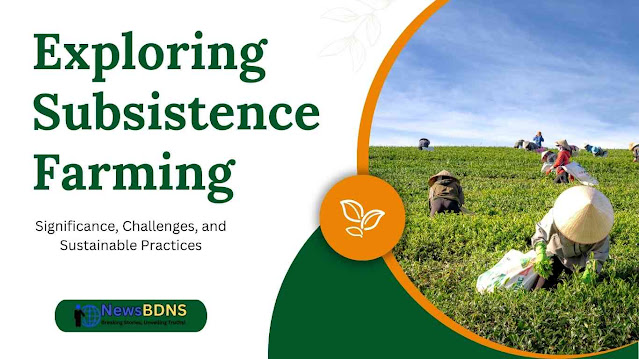Exploring Subsistence Farming: Significance, Challenges, and Sustainable Practices
Subsistence farming, a practice deeply embedded in the fabric of rural societies, refers to a mode of agricultural production where farmers cultivate crops and rear livestock primarily to meet the needs of their own families or communities. This method of farming contrasts with commercial agriculture, which focuses on producing goods for sale and profit. Subsistence farming has been a cornerstone of many local economies, playing a vital role in ensuring food security and sustaining livelihoods.
Over time, the shift from subsistence farming to modern agriculture has brought about significant changes in agricultural practices. While modern methods have led to increased productivity, they have also introduced challenges such as environmental degradation and loss of traditional knowledge. Despite these shifts, subsistence farming continues to hold cultural and historical significance in various parts of the world.
Characteristics of Subsistence Farming
Small-scale production
Subsistence farming typically involves small land holdings and limited resources. Farmers work on plots that are just sufficient to support their families, focusing on self-sufficiency rather than surplus production for trade.
Diverse crops and livestock
A hallmark of subsistence farming is the cultivation of a variety of crops and the rearing of various livestock species. This diversity helps mitigate risks associated with pests, diseases, and market fluctuations.
Limited use of modern technology
Unlike modern industrial agriculture, subsistence farming relies on traditional tools and techniques passed down through generations. Farmers use simple tools, often eschewing the heavy machinery employed in larger-scale operations.
Self-sufficiency as the primary goal
The primary objective of subsistence farming is to provide sustenance for the farmer's family and community. The surplus, if any, is usually minimal and used for barter or local trade rather than widespread distribution.
Types of Subsistence Farming
Shifting Cultivation (Slash-and-Burn)
Shifting cultivation involves clearing a piece of land, cultivating it for a few years until soil fertility declines, and then moving to a new plot. The cleared land is left fallow to recover, while a new area is prepared. This practice, while sustainable when population density was low, has raised concerns due to its environmental impact and land scarcity in modern times.
Intensive Subsistence Farming
Common in densely populated regions, intensive subsistence farming relies on high labor input. Farmers work tirelessly on small plots to maximize yields, often growing labor-intensive crops such as rice. This method supports local food needs but can be vulnerable to factors like weather fluctuations.
Pastoral Nomadism
In regions with limited arable land, pastoral nomadism is practiced. Communities rely on herding and grazing livestock as their main source of sustenance. They move from one grazing area to another in search of fresh pastures, embracing a nomadic way of life.
Importance and Challenges
Role in Food Security
Subsistence farming plays a crucial role in ensuring local food security. It provides a direct source of sustenance for families, reducing their dependency on external food sources and market fluctuations.
Cultural Significance and Traditional Practices
Subsistence farming is intertwined with cultural practices and traditions. It preserves indigenous knowledge and farming techniques passed down through generations, contributing to the unique identity of various communities.
Challenges of Modernization
Despite its value, subsistence farming faces challenges in the modern world. Limited access to resources, education, and markets hinder its growth potential. Additionally, subsistence farmers are often vulnerable to the impacts of climate change and global market fluctuations.
Advantages and Disadvantages
Advantages of Subsistence Farming
1. Lower Environmental Impact: Subsistence farming often involves sustainable practices with minimal chemical inputs, reducing the negative impact on the environment.
2. Preservation of Traditional Knowledge: Traditional farming methods are passed down through generations, preserving invaluable knowledge about local ecosystems and agriculture.
3. Enhanced Community Cohesion: Subsistence farming fosters a strong sense of community as neighbors come together to share resources and knowledge.
Disadvantages of Subsistence Farming
1. Limited Economic Growth: Due to its focus on self-sufficiency, subsistence farming offers limited opportunities for economic growth and development.
2. Risk of Poverty and Malnutrition: Reliance on subsistence farming can lead to poverty and malnutrition, especially when yields are low or unpredictable.
3. Lack of Access to Modern Amenities: Remote subsistence farming communities often lack access to modern amenities like healthcare, education, and infrastructure.
Examples from Different Regions
Subsistence Farming in Africa
In many African countries, subsistence farming remains a vital source of livelihood for rural communities. However, changing climate patterns and soil degradation pose significant challenges to food security and economic stability.
Subsistence Farming in Asia
Asia's subsistence farming landscape is diverse, with rice cultivation being a common practice. Efforts are being made to enhance productivity sustainably through practices like System of Rice Intensification (SRI).
Subsistence Farming in South America
Indigenous communities in South America have historically practiced subsistence farming, blending traditional knowledge with modern techniques. Balancing these practices while preserving cultural heritage is a constant challenge.
Strategies for Improvement
Agricultural Diversification
Encouraging farmers to diversify their crops and livestock can enhance resilience against environmental and market shocks.
Access to Education and Training
Providing subsistence farmers with education and training in modern agricultural techniques can empower them to increase their productivity sustainably.
Integration of Sustainable Practices
Promoting sustainable practices such as agroforestry, organic farming, and water conservation can improve the long-term viability of subsistence farming.
Support for Market Linkages
Facilitating access to markets and value chains can help subsistence farmers earn a better income and improve their overall livelihoods.
Conclusion
Subsistence farming, while facing challenges in a rapidly changing world, remains a critical aspect of many cultures and local economies. Its preservation holds the key to sustaining traditional knowledge, promoting community cohesion, and ensuring food security. As we move forward, it's important to strike a balance between modernization and the preservation of the values embedded within subsistence farming practices. By supporting subsistence farmers with appropriate strategies and resources, we can uphold their vital role in shaping the agricultural landscape.





